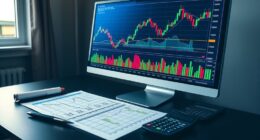FIRE Movement 2.0 helps you adapt your early retirement goals to a post-pandemic world by emphasizing flexibility, technology, and community support. You shift from aggressive saving to smarter investments like index funds, real estate, and alternative assets, ensuring resilience amid economic changes. Connecting with online groups and using digital tools can boost motivation and streamline your progress. To learn practical strategies for adjusting your FIRE journey, keep exploring how these new approaches fit into your future plans.
Key Takeaways
- Emphasize flexible, resilient investment strategies that adapt to economic uncertainties and market fluctuations post-pandemic.
- Leverage technology tools for smarter budgeting, automation, and data-driven adjustments to optimize savings.
- Expand diversification with alternative assets like real estate and digital investments to mitigate risks.
- Foster community support for shared learning, accountability, and motivation amid changing financial landscapes.
- Reevaluate personal goals regularly to align lifestyle choices with evolving economic realities and individual values.

The FIRE Movement 2.0 is transforming how people approach financial independence and early retirement by integrating new strategies and technology. This evolution isn’t just about saving aggressively anymore; it’s about smart, adaptable tactics that reflect a changing economic landscape. You now have access to a broader array of investment strategies that can help accelerate your journey. Whether it’s diversifying your portfolio with index funds, exploring real estate, or engaging in alternative investments like cryptocurrencies, FIRE 2.0 encourages you to leverage innovative options suited to your risk tolerance and goals. The focus is on making your money work harder for you, especially in uncertain times shaped by the pandemic’s economic ripple effects.
Alongside refined investment strategies, community building plays a crucial role in FIRE Movement 2.0. You’re no longer mastering financial independence in isolation; instead, you’re part of a growing, interconnected network. Online forums, social media groups, and local meetups offer platforms for sharing insights, experiences, and encouragement. This sense of community becomes a powerful motivator, helping you stay committed when challenges arise. It also provides opportunities to learn from others’ successes and mistakes, which can refine your approach and prevent costly errors. Community building fosters accountability and creates a support system that makes the journey more engaging and sustainable. Incorporating technology further enhances your ability to track progress and stay connected with like-minded individuals.
Community networks, online forums, and meetups fuel motivation, accountability, and shared learning for sustainable FIRE journey success.
Technology is at the core of FIRE 2.0, giving you tools to optimize your savings, track your progress, and access educational resources. Budgeting apps, automated investment platforms, and financial planning tools simplify complex tasks and help you stay on course. These advancements empower you to make data-driven decisions, adjust your strategies as needed, and avoid common pitfalls. As the world adapts to new economic realities, these tools guarantee you remain flexible and responsive. They also facilitate community engagement, as many FIRE enthusiasts share tips and insights through digital channels, strengthening the collective knowledge base.
Ultimately, FIRE Movement 2.0 encourages you to rethink how you approach early retirement. It emphasizes adaptability, continuous learning, and community support, all enabled by technology. By integrating innovative investment strategies and building meaningful connections with like-minded individuals, you’re better equipped to maneuver the post-pandemic economy. This new phase isn’t just about reaching a financial target; it’s about creating a resilient, fulfilling lifestyle that aligns with your values and future aspirations. Staying informed, connected, and open to new opportunities will be your keys to success in this evolving movement.
Frequently Asked Questions
How Has the Pandemic Changed FIRE Investment Strategies?
The pandemic has shifted your FIRE investment strategies by emphasizing diversification and inflation hedging. You now focus on spreading your investments across asset classes to reduce risks and protect against market volatility. Additionally, you prioritize assets that serve as inflation hedges, like real estate or commodities, to safeguard your purchasing power. These adjustments help you stay resilient in uncertain economic times and ensure your early retirement plans stay on track despite post-pandemic challenges.
What New Risks Should FIRE Adherents Consider Post-Pandemic?
Picture walking a tightrope over shifting terrain, your safety net fragile. Post-pandemic, you should consider risks like pandemic resilience, where future health crises could disrupt your plans, and social safety, which might weaken as economic inequalities grow. Stay alert to these threats, diversifying income sources and building stronger community ties, so your journey remains steady even when the landscape beneath you shifts unexpectedly.
How Do Healthcare Costs Impact FIRE Plans Now?
Healthcare costs now markedly impact your FIRE plans, especially with rising healthcare inflation and increasing insurance premiums. You need to account for these expenses in your early retirement budget, as they can eat into your savings faster than expected. By planning for higher medical costs and exploring affordable insurance options, you can better protect your financial independence and ensure your retirement remains secure, even amid rising healthcare expenses.
Are Remote Work Opportunities Influencing FIRE Timelines?
They say, “The early bird catches the worm,” and remote work opportunities are giving you a chance to redefine your timeline. As digital nomads and remote workers, you can potentially accelerate your FIRE plans by working from anywhere, extending your earning years or reducing expenses. This flexibility might shorten your path to financial independence, showing that adaptability is key in today’s evolving work landscape.
How Can FIRE Followers Adapt to Economic Instability?
You can adapt to economic instability by building financial resilience through diversified income streams and emergency funds. Prioritize maintaining lifestyle flexibility, so you’re prepared for unexpected changes. Keep a close eye on market shifts and adjust your savings and investments accordingly. This proactive approach helps you stay on track toward your early retirement goals, even amid economic uncertainties, ensuring your financial security and freedom remain intact.
Conclusion
As you navigate the evolving landscape of FIRE Movement 2.0, think of your goals as a sturdy ship charting new waters. Adaptability becomes your compass, guiding you through post-pandemic waves. Embrace change with confidence, knowing that your journey to early retirement isn’t a straight line but a voyage filled with twists and turns. Keep your eyes on the horizon, stay flexible, and steer your ship wisely—your future freedom awaits beyond the horizon’s bend.










